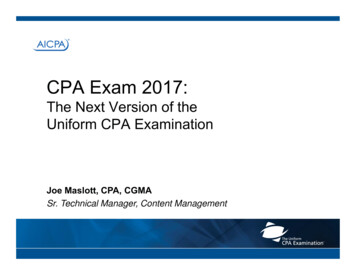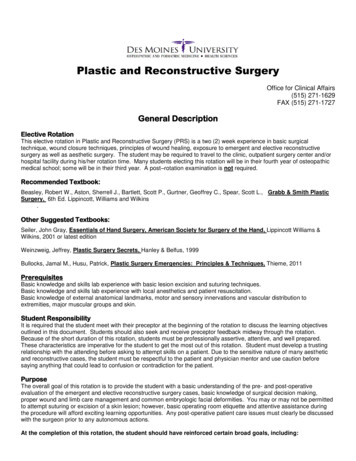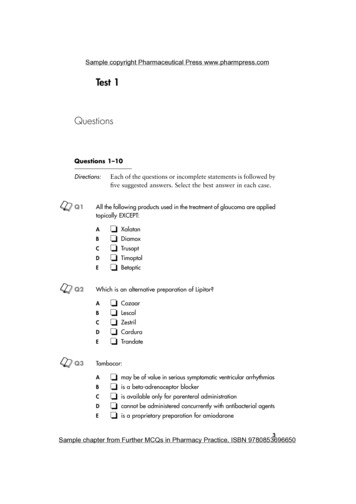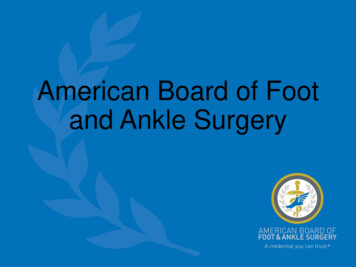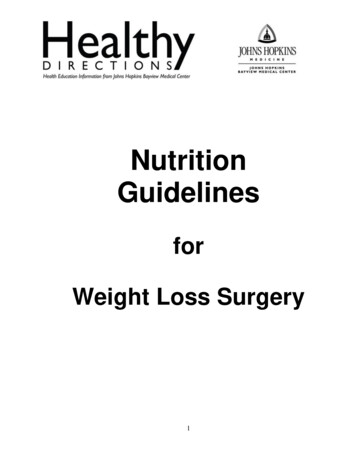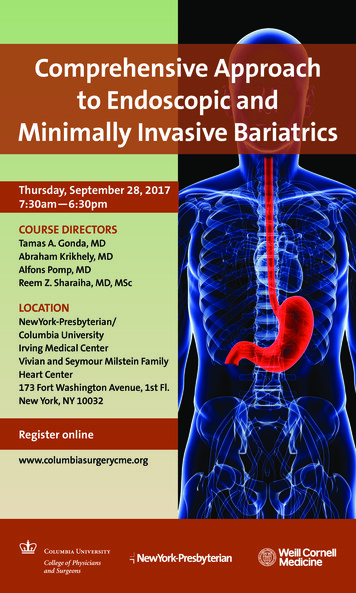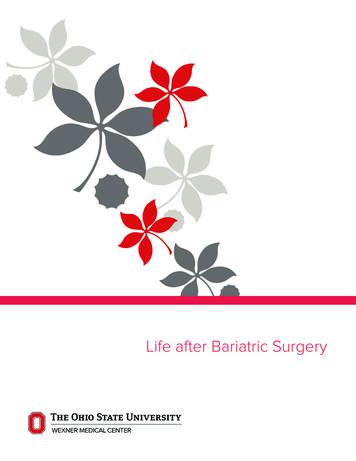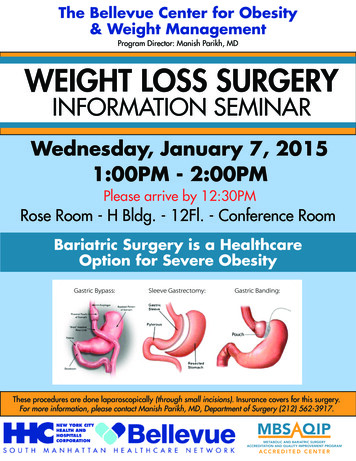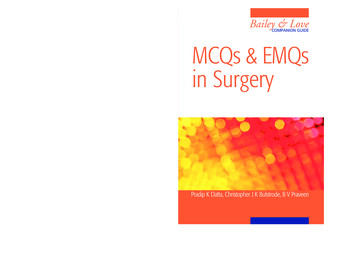
Transcription
990674 MCQ As Surgery CV 3 ARNOLD 22/04/2010 15:21 Page 1B&LCOMPANION GUIDEWith over 1000 questions, MCQs and EMQs in Surgery is the ideal self-assessmentcompanion guide to Bailey & Love’s Short Practice in Surgery. The book assists readers in theirpreparation for examinations and enables them to test their knowledge of the principles andpractice of surgery as outlined within Bailey & Love.Sub-divided into 13 subject-specific sections, both MCQs and EMQs provide a comprehensivecoverage of the surgical curriculum as well as the core learning points as set out in Bailey & Love.Each section emphasises the importance of self-assessment within effective clinicalexamination and soundly based surgical principles, whilst taking into account the latestdevelopments in surgical practice.MCQs and EMQs in Surgery is an excellent companion to Bailey & Love and provides avaluable revision tool for those studying for MRCS.One of the world's pre-eminent medical textbooks beloved bygenerations of surgeons.To find out more visit www.baileyandlove.comI S B N 978-0-340-99067-49780340 990674Bailey & LoveCOMPANION GUIDEMCQs & EMQsin SurgeryDatta Bulstrode PraveenAbout the authorsPradip K Datta MBE, MS, FRCS (Ed, Eng, Irel, Glas) is Honorary Consultant Surgeon, CaithnessGeneral Hospital, Wick, Member of Council and College Tutor, Royal College of Surgeons ofEdinburgh.Christopher J K Bulstrode MCh, FRCS (Orth) is Professor and Honorary Consultant Traumaand Orthopaedic Surgeon, University of Oxford, Member of Council, Royal College ofSurgeons of Edinburgh.B V Praveen MS, FRCS (Ed, Eng, Glas, Irel, Gen) is Consultant Surgeon and Associate Director ofMedical Education, Southend University Hospital, Honorary Senior Lecturer, Queen Mary,University of London.MCQs & EMQs in SurgeryBailey & LovePradip K Datta, Christopher J K Bulstrode, B V Praveen
Bailey & LoveCOMPANION GUIDEMCQs andEMQs inSurgeryPradip K Datta MBE, MS, FRCS (Ed, Eng, Irel, Glasg), HonoraryConsultant Surgeon, Caithness General Hospital, Wick, Member ofCouncil and College Tutor, Royal College of Surgeons of EdinburghChristopher J K Bulstrode MCh, FRCS (Orth), Professor andHonorary Consultant Trauma and Orthopaedic Surgeon, University ofOxford, Member of Council, Royal College of Surgeons of EdinburghB V Praveen MS, FRCS (Ed, Eng, Glasg, Irel, Gen), ConsultantSurgeon and Associate Director of Medical Education, SouthendUniversity Hospital, Honorary Senior Lecturer, Queen Mary, Universityof LondonPrelimsxvi.indd i4/14/2010 2:31:03 PM
CRC PressTaylor & Francis Group6000 Broken Sound Parkway NW, Suite 300Boca Raton, FL 33487-2742 2010 by Taylor & Francis Group, LLCCRC Press is an imprint of Taylor & Francis Group, an Informa businessNo claim to original U.S. Government worksVersion Date: 20121026International Standard Book Number-13: 978-1-4441-2829-1 (eBook - PDF)This book contains information obtained from authentic and highly regarded sources. Reasonableefforts have been made to publish reliable data and information, but the author and publisher cannotassume responsibility for the validity of all materials or the consequences of their use. The authors andpublishers have attempted to trace the copyright holders of all material reproduced in this publicationand apologize to copyright holders if permission to publish in this form has not been obtained. If anycopyright material has not been acknowledged please write and let us know so we may rectify in anyfuture reprint.Except as permitted under U.S. Copyright Law, no part of this book may be reprinted, reproduced,transmitted, or utilized in any form by any electronic, mechanical, or other means, now known orhereafter invented, including photocopying, microfilming, and recording, or in any information storage or retrieval system, without written permission from the publishers.For permission to photocopy or use material electronically from this work, please access www.copyright.com (http://www.copyright.com/) or contact the Copyright Clearance Center, Inc. (CCC), 222Rosewood Drive, Danvers, MA 01923, 978-750-8400. CCC is a not-for-profit organization that provides licenses and registration for a variety of users. For organizations that have been granted a photocopy license by the CCC, a separate system of payment has been arranged.Trademark Notice: Product or corporate names may be trademarks or registered trademarks, and areused only for identification and explanation without intent to infringe.Visit the Taylor & Francis Web site athttp://www.taylorandfrancis.comand the CRC Press Web site athttp://www.crcpress.com
ementsxiiList of Abbreviations UsedxiiiIntroductionxviPART 1: PRINCIPLES11 The metabolic response to injury3 Pradip Datta2 Shock and blood transfusion8 Bandipalyam Praveen3 Wounds, tissue repair and scars16 Bandipalyam Praveen4 Surgical infection22 Bandipalyam Praveen5 Tropical surgery31 Pawanindra Lal, Sanjay De Bakshi6 Paediatric surgery75 Pradip Datta7 Oncology84 Bandipalyam Praveen8 Surgical audit and research90 Bandipalyam Praveen9 Surgical ethics94 Pradip Datta10 Diagnostic imaging96 Pradip DattaPART 2: INVESTIGATION AND DIAGNOSIS10111 Gastrointestinal endoscopy103 Bandipalyam PraveeniiiPrelimsxvi.indd iii4/14/2010 2:31:04 PM
CONTENTS12 Tissue diagnosis107 Pradip DattaPART 3: PERIOPERATIVE CARE11113 Preoperative preparation113 Bandipalyam Praveen14 Anaesthesia and pain relief118 Nigel Webster15 Care in the operating room122 Pradip Datta16 The high-risk surgical patient124 Bandipalyam Praveen17 Nutrition and fluid therapy127 Nandini Rao18 Basic surgical skills and anastomosis135 Pradip Datta19 Laparoscopic and robotic surgery137 Bandipalyam Praveen20 Postoperative care144 Pradip DattaPART 4: TRAUMA15121 Introduction to trauma153 Pradip Datta22 Trauma epidemiology156 Christopher Bulstrode23 Head injury160 Lynn Myles24 Neck and spine166 Christopher Bulstrode25 Trauma to the face and mouth171 Charles Perkins26 Trauma to the chest and abdomen176 Pradip DattaivPrelimsxvi.indd iv4/14/2010 2:31:04 PM
185 Christopher Bulstrode28 Burns195CONTENTS27 Extremity trauma John McGregor29 Plastic and reconstructive surgery205 John McGregor30 Disaster surgery212 Christopher BulstrodePART 5: ELECTIVE ORTHOPAEDICS21731 Elective orthopaedics: musculoskeletal examination219 Christopher Bulstrode32 Sports medicine224 Christopher Bulstrode33 The spine233 Christopher Bulstrode34 The upper limb238 Christopher Bulstrode35 The hip and knee246 Christopher Bulstrode36 The foot and ankle252 Christopher Bulstrode37 Infection and tumours257 Christopher Bulstrode38 Paediatric orthopaedics264 Christopher BulstrodePART 6: SKIN AND SUBCUTANEOUS TISSUE27139 Skin and subcutaneous tissue273 Pradip DattaPART 7: HEAD AND NECK28140 Elective neurosurgery283 Lynn MylesvPrelimsxvi.indd v4/14/2010 2:31:04 PM
CONTENTS41 The eye and orbit292 Brian Fleck42 Cleft lip and palate: developmentalabnormalities of face, mouth and jaws302 John McGregor43 The nose and sinuses309 Iain J Nixon44 The ear319 Iain J Nixon45 Pharynx, larynx and neck330 Iain J Nixon46 Oropharyngeal cancer341 Iain J Nixon47 Disorders of the salivary glands351 Iain J NixonPART 8: BREAST AND ENDOCRINE36148 Thyroid and the parathyroid gland363 Nandini Rao49 Adrenal glands and other endocrine disorders375 Nandini Rao50 The breast385 Pradip DattaPART 9: CARDIOTHORACIC38951 Cardiac surgery391 Dumbor Ngaage52 The thorax397 Dumbor NgaagePART 10: VASCULAR40353 Arterial disorders405 Peter McCollum54 Venous disorders411 Peter McCollumviPrelimsxvi.indd vi4/14/2010 2:31:04 PM
416 Peter McCollumPART 11: ABDOMINAL42156 History and examination of the abdomen423CONTENTS55 Lymphatic disorders Pradip Datta57 Hernia, umbilicus and abdominal wall425 Bandipalyam Praveen58 The peritoneum, omentum, mesenteryand retroperitoneal space432 Pradip Datta59 The oesophagus437 Pradip Datta60 Stomach and duodenum441 Bandipalyam Praveen61 The liver451 Pradip Datta62 The spleen458 Pradip Datta63 The gall bladder and bile ducts461 Bandipalyam Praveen64 The pancreas468 Pradip Datta65 The small and large intestines474 Pradip Datta66 Intestinal obstruction488 Bandipalyam Praveen67 The vermiform appendix495 Pradip Datta68 The rectum499 Pradip Datta69 The anus and anal canal504 Bandipalyam PraveenviiPrelimsxvi.indd vii4/14/2010 2:31:04 PM
CONTENTSPART 12: GENITOURINARY51370 Urinary symptoms and investigations515 Pradip Datta71 The kidneys and ureters521 Pradip Datta72 The urinary bladder533 Pradip Datta73 The prostate and seminal vesicles541 Pradip Datta74 The urethra and penis546 Pradip Datta75 The testis and scrotum549 Pradip Datta76 Gynaecology554 Pradip DattaPART 13: TRANSPLANTATION55977 Transplantation561 Bandipalyam PraveenIndex569viiiPrelimsxvi.indd viii4/14/2010 2:31:04 PM
ForewordThis innovative companion volume will certainly be considered as anessential complement to Bailey & Love’s Short Practice of Surgery. Theauthors and contributors have recognised the fundamental changesthat have occurred in surgical training and assessment where greaterknowledge must be acquired in a shorter period of time, not only toensure success in examinations but also to provide the comprehensivefoundations on which to build clinical expertise. The Silver Jubileeedition of Bailey & Love in 2008 emphasised its enduring importance forgenerations of surgeons internationally. MCQs and EMQs in Surgery willdefine the indispensable elements for today’s surgical practitioners.John D Orr, FRCS (Ed)ixPrelimsxvi.indd ix4/14/2010 2:31:04 PM
ContributorsSanjay De Bakshi MS FRCS (Eng & Ed)Consultant Surgeon, Calcutta Medical Research Institute (CMRI), Kolkata,IndiaBrian W Fleck FRCS (Ed), MD Consultant Ophthalmic Surgeon, PrincessAlexandra Eye Pavilion and Royal Hospital for Sick Children, EdinburghProfessor Pawanindra Lal MS DNB MNAMS FRCS (Ed & Eng)Professor of Surgery, Maulana Azad Medical College, New Delhi, IndiaProfessor Peter McCollum MCh, FRCS (Ed), FRCSIProfessor of Vascular Surgery, Hull/York Medical SchoolJohn C McGregor BSc (Hons) MBChB (with commendation) FRCS, FRCS(Edin)Former Consultant in Plastic, Reconstructive and Cosmetic Surgery,St John’s Hospital, West LothianLynn Myles BSc (Hons), MB ChB, MD, FRCS (SN)Consultant Neurosurgeon, Department of ClinicalNeurosciences, Western General Hospital, EdinburghDumbor L Ngaage MB BS FRCS (Ed), FWACS, FRCS (C-Th), FETCS(Cardiovascular), FETCS (Thoracic), MSSpecialist Registrar in Cardiothoracic Surgery, Castle Hill Hospital, Hull.Honorary Clinical Tutor, Hull York Medical School, Universities of Hull &YorkIain J. Nixon MBChB FRCS (Edin.) Specialist Registrar in OtolaryngologyHead and Neck Surgery, West of Scotland Rotation. Clinical ResearchFellow, Memorial Sloan Kettering Cancer Center, New York, USACharles S Perkins FDSRCS, FFDRCSI, FRCSConsultant Oral and Maxillofacial Surgeon, Gloucestershire Royal andCheltenham General Hospitals, GloucestershireNandini P Rao, MRCP, MscSpecialist Registrar in Chemical Pathology/Metabolic Medicine, Royal FreeHospital, LondonProfessor N R Webster MB ChB PhD FRCA FRCP FRCSInstitute of Medical Sciences, Foresterhill, AberdeenxPrelimsxvi.indd x4/14/2010 2:31:04 PM
PrefaceFirst published in 1932, Bailey & Love’s Short Practice of Surgery hasstood the test of time. Perhaps this is an understatement, consideringthat all three of us have used the book as medical students! This bookhas been the result of good foresight on the part of Hodder Arnold tokeep up with the changing trends in the pattern of surgical examinations,both at undergraduate and postgraduate levels. The publishers shouldbe congratulated in bringing out this book – converting the originalSilver Jubilee (25th) edition – all 77 chapters of it – as Multiple ChoiceQuestions (MCQs) and Extended Matching Questions (EMQs).The book is aptly titled as a companion to Bailey & Love. We wouldtherefore hope that the reader, specifically preparing for a writtenexamination, would use this book as the major reading material, referringto the original for detailed elucidation of a particular point or operativedetail.Most of the contributors are different from Bailey & Love’s ShortPractice of Surgery except for chapters 5, 25 the section on orthopaedicsand part of trauma. Thus while retaining the essence of the originalmaterial, this book has been seasoned by different authors, thus givingit a fresh flavour without losing any of its original ingredients. We aregrateful to all the contributors for their prompt response in spite of thepressures of work in the National Health Service.The images and pictures are mostly different to those in the originalbook, giving this tome an added attraction. While the MCQs testknowledge, the EMQs with the illustrations give a good format for aself-assessment exercise. The chapters are specifically geared towardshelping the reader with preparation for the written papers of the MRCSand FRCS(Gen) examinations. The undergraduate will also find this bookequally stimulating for the same reasons. In surgical examinations inthe English-speaking world, where essays have been replaced by shortanswer questions (short notes of yesteryear), the reader will find theEMQs ideal preparation.Any book must be dynamic, much more so a new venture such asthis. It was said in the preface of the parent book, “Whereas the pastinforms the present, it must never enslave the future.” As authors of thisvery exciting project we can stay true to the spirit of this statement onlywith help from you – our readers. Therefore we look forward to yoursuggestions and constructive criticisms for the next edition.Pradip K DattaChristopher J K BulstrodeB V PraveenNovember 2009xiPrelimsxvi.indd xi4/14/2010 2:31:04 PM
AcknowledgementsAn email from Gavin Jamieson to one of us (PKD) was the inspirationbehind this publication, he being the catalyst who set alight ourenthusiasm to write this book. Thus to him we owe a huge debt ofgratitude for getting this project off the ground. Indeed it is a tribute to allconcerned that this book was published in just over a year since the ideawas born as his brainchild.All the contributors have done a tremendous job not only in producingcomprehensive chapters but also delivering them on time – and this, inspite of the pressures of the present-day National Health Service; to themwe are grateful. Francesca Naish, as editorial manager, has kept the teamon track by liaising with us all on a regular basis, thus bringing our effortsto fruition. We give our thanks to her. To Jane Utting we are grateful forher meticulous proofreading. Thanks are also due to Adam Campbell forhis efficient and prompt copy-editing.We are very grateful to Mr John D Orr, immediate Past President ofthe Royal College of Surgeons of Edinburgh for writing the foreword.Finally, our great appreciation goes to our families (Swati, Sandip, Victoria,Harry, John-James, Jenny, Nandini and Prakruti) for their encouragementand support. We dedicate this book to them.PKDCJKBBVPxiiPrelimsxvi.indd xii4/14/2010 2:31:05 PM
List of Abbreviations il5-hydroxyindoleacetic acidabdominal aortic aneurysmsairways, breathing, circulation anddisabilityarterial blood gasesabdominal compartment syndromeadrenocorticotrophic hormoneantidiuretic hormoneadenosine diphosphateatrial fibrillationalpha-fetoproteinanal intraepithelial neoplasiaantilymphocytic globulinalkaline phosphataseantilymphocytic serumalanine transaminaseantineutrophil cytoplasmic antibodiesaberrations of normal developmentand involutionatrial natriuretic factoratrial natriuretic peptideanteroposterioradenomatous polyposis coliacute respiratory distress syndromeaspartate transaminaseAdvanced Trauma Life Supportadrenal vein catheterisationarteriovenous malformationsbasal cell carcinomaBacillus Calmette Guérinbody mass indexbladder outflow obstructionblood pressureBenign prostatic hypertrophybenign paroxysmal positional vertigocoronary artery bypass graftcongenital adrenal hyperplasiacommon bile ductcharge-coupled devicecholecystokininCrohn’s diseasecarcinoembryonic anced computedtomographycommon hepatic ductCreutzfeldt–Jakob Diseasecytomegaloviruscentral nervous systemChronic obstructive airways diseasechronic obstructive pulmonary diseasecorticotrophin-releasing factorchronic renal failureCortisol-releasing hormoneC-reactive proteincervical spinecerebrospinal fluidCortisol-releasing hormoneComputed tomographycardiovascular accidentcentral venous isseminated intravascular coagulationdiffuse idiopathic spinal hyperostosisdiabetic ketoacidosisdiagnostic laparoscopydifferential leucocyte countdiastase periodic acid-Schiff/diastasePASdiagnostic peritoneal lavagedigital rectal examinationdiethyltriaminepentacetic aciddeep vein thrombosisEpstein–Barr inetetra-acetic acidenterochromaffin-likeenzyme-linked immunosorbent assayendoscopic retrogradecholangiopancreatographyEnhanced Recovery Programmeerythrocyte sedimentation rateextracorporeal shock wave lithotripsyexamination under anaesthesiaxiiiPrelimsxvi.indd xiii4/14/2010 2:31:05 PM
LIST OF ABBREVIATIONS USEDEuroSCORE European System for CardiacOperative Risk EvaluationEUSendoluminal ultrasoundEUSEndosonographyEVLTendovascular laser treatmentFAPfamilial adenomatous polyposisFASTfocused assessment withsonography for traumaFBforeign bodyFBCfull blood countFDGflurodeoxyglucoseFEV1forced expiratory volume in 1 secFFPfresh frozen plasmaFHHfamilial hypocalciurichypocalcaemiaFISHfluorescence in-situ hybridisationFNACfine-needle aspiration cytologyFSHfollicle-stimulating hormonefT3free T3fT4free T4GALTgut-associated lymphoid tissueGCSGlasgow Coma ScaleGDTgoal-directed therapyGGTgamma-glutamyl transpeptidaseGHgrowth hormoneGIgastrointestinalGISTgastrointestinal stromal tumoursGITgastrointestinal tractGOOgastric outlet obstructionGORDgastro-oesophageal reflux diseaseGRHgonadotrophin-releasing hormoneGSIgenuine stress incontinenceGTNglyceryl trinitrateGVHDgraft-versus-host diseaseHAARTHighly Active Anti-Retroviral TherapyHAIhealth care-associated infectionHbhaemoglobinHCChepatocellular carcinomaHCGhuman chorionic gonadotrophinHHhiatus herniaHHThereditary haemorrhagictelangiectasiaHLAhuman leucocyte antigenHNPCChereditary non-polyposis human papillomavirusintracranial pressureintensive care unitischaemic heart diseaseintramuscularinternational normalised ratioInternational Prostate Symptom Scoreidiopathic thrombocytopenic purpuraintensive treatment unitintrauterine contraceptive deviceintravenousinferior vena cavaintravenous urogramjugular venous pressurekidney, ureter and bladderlactate dehydrogenaseliver function testsluteinising hormoneluteinising hormone-releasing hormoneleft iliac fossalaryngeal mask airwaylast menstrual periodlow-osmolality contrast medialower oesophageal sphincterlumbar puncturelower urinary tract symptomsleft ventricularmucosa-associated lymphoid tissuemicrosomal antibodyminimal access surgerymultiple endocrine neoplasia type 1myocardial infarctiontechnetium-99m-labelled sestamibiisotopemalignant melanomamultiple organ dysfunction syndromemultiple organ failuremagnetic resonance angiographymagnetic resonancecholangiopancreatographymagnetic resonance imagingmethicillin-resistasnt Staphylococcusaureusmelanocyte-stimulating hormonemultiple system organ failurexivPrelimsxvi.indd xiv4/14/2010 2:31:05 PM
U&EUCUICCUSUTIVACVATSVPVPCWCCWHOsystemic inflammatory responsesyndromesystemic lupus erythematosussentinel lymph node biopsysphincter of Oddi dysfunctionsingle photon emission computedtomographysimultaneous pancreas and kidneytransplantsolitary rectal ulcer syndromesurgical site infectionsslipped upper femoral epiphysissuperior vena cavatransabdominal preperitoneal repairtotal body surface areatotal body waterthromboembolic deterrent (stockings)total extraperitoneal repairthyroid function teststransforming growth factortransient ischaemic attacktransjugular intrahepatic portosystemicstent shunttotal intravenous anaesthetictotal leucocyte counttumour necrosis factorclassification of malignant tumours(tumour, nodes, metastasis)total parenteral nutritionthyroid peroxidase antibodiestransrectal ultrasound-guided biopsythyroid-stimulating hormonetransurethral resection of the prostateurea and electrolytesulcerative colitisUnion Internationale Contre le Cancerultrasoundurinary tract infectionvacuum-assisted closurevideo-assisted thoracoscopyventriculoperitonealvapour pulse coagulationwhite cell countWorld Health OrganizationLIST OF ABBREVIATIONS USEDMUST Malnutrition Universal Screening ToolNAInon-accidental injuryNETs neuroendocrine tumoursNOTES natural orifice transluminal surgeryNRES National Research Ethics ServiceNSAIDs non-steroidal anti-inflammatory drugsOCP oral contraceptive pillOGD oesophagogastroduodenoscopyOPSI opportunist post-splenectomy infectionOPT orthopantomogramORIF open reduction and internal fixationPASperiodic acid-SchiffPCA patient-controlled analgesiaPCNL percutaneous nephrolithotomyPCR polymerase chain reactionPDGF platelet-derived growth factorPEpulmonary embolismPETpositron emission tomographyPETs pancreaticoduodenal endocrinetumoursPHA primary hyperaldosteronismPIDpelvic inflammatory diseasePOC Per-Operative CholangiogramPPIs proton pump inhibitorsPSAprostate-specific antigenPSARP posterior sagittal anorectoplastyPSCprimary sclerosing cholangitisPTprothrombin timePTCpercutaneous transhepaticcholangiographyPTH parathyroid hormonePTLD post-transplant lymphoproliferativedisorderPTTpartial thromboplastin timePUJpelviureteric junctionPVPpolyvinylpropyleneRTradiotherapyRTAroad traffic accidentRUQ right upper quadrantRVright ventricularSAH subarachnoid haemorrhageSCC squamous cell carcinomaSIADH syndrome of inappropriate antidiuretichormone hypersecretionxvPrelimsxvi.indd xv4/14/2010 2:31:05 PM
IntroductionBailey & Love’s Short Practice of Surgery celebrated the publication ofits Silver Jubilee edition in 2008. It has certainly come a long way sincethe first edition was published in 1932. As authors of this book (CJKBbeing one of the editors of Bailey & Love), dare we say that the title ofthe book is a misnomer. It is anything but a ‘Short Text Book’. Editionsof yesteryear consisted of some 1300 pages of single column text. Thecurrent edition consists of over 1500 pages, each containing a doublecolumn.Arguably Bailey & Love is not just a text book. Many students andteachers of surgery the world over use it as a reference book too. Todayboth postgraduate and undergraduate examinations lay emphasis onknowledge rather than presentation and the nuances of essay writing.Thus for many years, the candidate’s test of theory knowledge inexaminations has been based on Multiple Choice Questions (MCQs)and Extended Matching Questions (EMQs), sometimes supplemented bySingle Best Answers (SBAs).Therefore for the first time in this book, all 77 chapters of Bailey &Love have been converted into MCQs and EMQs. We, as authors, alongwith the other contributors, have reproduced the original text in thisform of MCQs and EMQs. We hope that we have accurately mirroredthe subject matter. Most of the images in this book are not from Bailey &Love, but are from the personal collection of one of the authors (PKD).We hope that this book will be useful for medical students studyingsurgery in the English-speaking world and for those doing MRCS andFRCS (Gen) examinations in the UK. As authors of the very first suchundertaking, we would welcome suggestions for future editions from ourreaders.PKDCJKBBVPxviPrelimsxvi.indd xvi4/14/2010 2:31:05 PM
PART1Principles1 The metabolic response to injury32 Shock and blood transfusion83 Wounds, tissue repair and scars164 Surgical infection225 Tropical surgery316 Paediatric surgery757 Oncology848 Surgical audit and research909 Surgical ethics9410 Diagnostic imagingCH001.indd 1964/2/2010 1:17:57 PM
This page intentionally left blank
1The metabolic response toinjuryMultiple choice questions Homeostasis1. Which of the following statementsabout homeostasis are false?A It is defined as a stable state of thenormal body.B The central nervous system, heart, lungs,kidneys and spleen are the essentialorgans that maintain homeostasis at anormal level.C Elective surgery should cause littledisturbance to homeostasis.D Emergency surgery should cause littledisturbance to homeostasis.E Return to normal homeostasis afteran operation would depend upon thepresence of co-morbid conditions. Stress response2. In stress response, which of thefollowing statements are false?A It is graded.B Metabolism and nitrogen excretion arerelated to the degree of stress.C In such a situation there arephysiological, metabolic andimmunological changes.D The changes cannot be modified.E The mediators to the integrated responseare initiated by the pituitary.B Every endocrine gland plays an equalpart.C They produce a model of several phases.D The phases occur over several days.E They help in the process of repair. The recovery process4. With regard to the recovery process,identify the statements that are true.A All tissues are catabolic, resulting in repairat an equal pace.B Catabolism results in muscle wasting.C There is alteration in muscle proteinbreakdown.D Hyperalimentation helps in recovery.E There is insulin resistance. Optimal perioperative care5. Which of the following statements aretrue for optimal perioperative care?A Volume loss should be promptly treatedby large intravenous (IV) infusions offluid.B Hypothermia and pain are to be avoided.C Starvation needs to be combated.D Avoid immobility.E Helpful measures can be taken. Mediators3. Which of the following statementsabout mediators are true?A They are neural, endocrine andinflammatory.3CH001.indd 34/2/2010 1:17:58 PM
PRINCIPLESAnswers: Multiple choice questions Homeostasis1. DThe normal physiological state of the human body is referred to as homeostasis – a normalinternal environment (the milieu intérieur of Claude Bernard). All the vital organs – thebrain, heart, lungs, kidneys and, to a lesser extent, the spleen – play an important role in itsmaintenance. These organs are interdependent and thus help to maintain a normal fluid andacid–base balance.In the elective situation, the patient is always optimised prior to any operation, therebyminimising the homeostatic disturbance. The extent of surgery also plays a part. Disturbance inthe homeostasis to some degree occurs in emergency surgery; this depends upon the extentof injury, presence of sepsis and any ongoing insults. If the patient has co-morbid conditions,postoperatively the return to normal homeostasis would take longer than in those with noco-morbidity. In such cases, care in a high-dependency or intensive care unit (ICU) is essential. Stress response2. DThe stress response is graded according to the injury inflicted. An elective operation in a fit patient,such as a laparoscopic cholecystectomy in a 30-year-old female, will elicit a minor transientstress response from which the patient recovers quite quickly. On the other hand, a severelyinjured patient of 70 will elicit a major response, requiring care in the ICU (see Fig. 1.1). Thereis an increase in metabolism and nitrogen excretion in direct proportion to the injury. There areimmunological and metabolic changes which are reflected in the physiology – pyrexia, tachycardiaand tachypnoea. The body’s innate defence mechanisms can combat mild stress, and return tonormal physiology occurs very soon.Stress response depends uponSeverity of injuryType of injuryTo get speedy resolution avoid (‘SO’)Secondary insults – 3 Is: IschaemiaInfectionInadequate oxygenation (hypoxia)Ongoing trauma, e.g. compartment syndrome (abdominal/limb)Figure 1.1 Metabolic response to severe trauma.In severe injury, the stress response can be modified by anticipating complications andpreventing them by judicious management in an ICU, i.e. attention to nutrition and anticipationand prevention of secondary insults such as ischaemia, infection, hypoxia and compartmentsyndrome.4CH001.indd 44/2/2010 1:17:58 PM
Mediators3. A, B, EStress from injury travels along afferent pathways of the spinal cord to the hypothalamuswhich secretes the corticotrophin-releasing factor (CRF) that acts on the pituitary to secreteadrenocorticotrophic hormone (ACTH) and growth hormone (GH). This creates the ‘flight or fight’response. The pancreas increases glucagon secretion. Other endocrines, thyroid and gonads play aminor role. This concerted neuroendocrine response results in lipolysis, hepatic gluconeogenesis,protein breakdown, pyrexia and hypermetabolism. Cytokines, interleukins (IL-1, IL-6) and tumournecrosis factor-alpha (TNF ) are simultaneously released (see Fig. 1.2).Catecholamine-mediated‘fight or flight’ responseAdrenalineCytokinesHypothalamusAdrenal medullaNoradrenalinefrom peripheralnerves1: THE METABOLIC RESPONSE TO INJURYThe pituitary gland, rightly referred to as ‘the leader in the endocrine orchestra’ (Sir WalterLangdon-Brown, 1931), sets in motion the entire synchronous response. The body will bring intoplay neural, endocrine and inflammatory responses. The neural response that initiates and acts inconcert with the endocrines is referred to as the neuroendocrine response to trauma.
in Surgery With over 1000 questions, MCQs and EMQs in Surgeryis the ideal self-assessment companion guide to Bailey & Love’s Short Practice in Surgery. The book assists readers in their preparation for examinations and enables them to test their knowledge of the principles and practice of
